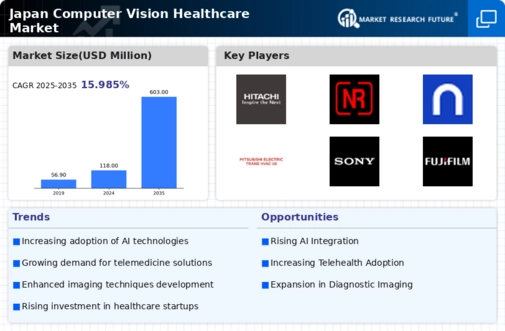Growing Focus on Preventive Healthcare
The focus on preventive healthcare is reshaping the computer vision healthcare market in Japan. As healthcare systems shift towards preventive measures, the demand for technologies that facilitate early detection and monitoring of diseases is increasing. Computer vision applications, such as automated screening tools, are becoming essential in identifying health issues before they escalate. This trend aligns with Japan's national health policies aimed at reducing healthcare costs and improving population health. The emphasis on preventive care is expected to drive market growth, as healthcare providers seek to implement solutions that enhance patient outcomes.
Increased Investment in Health Tech Startups
In Japan, there is a marked increase in investment in health tech startups, which is propelling the computer vision-healthcare market forward. Venture capital funding in the health tech sector has seen a rise of approximately 40% in the last year, indicating a strong interest in innovative solutions. Startups focusing on computer vision applications are attracting significant attention, as they develop tools that enhance diagnostic capabilities and patient management. This influx of capital is likely to foster innovation and accelerate the development of new technologies, thereby expanding the overall market landscape.
Technological Advancements in Imaging Systems
Technological advancements in imaging systems are significantly influencing the computer vision-healthcare market in Japan. Innovations such as high-resolution imaging and real-time data processing are enhancing diagnostic accuracy and efficiency. For instance, the introduction of AI-powered imaging tools has been shown to improve the detection rates of conditions like cancer and cardiovascular diseases. The medical imaging market is projected to reach $5 billion by 2027, reflecting a growing reliance on advanced imaging technologies. These advancements not only improve patient care but also optimize workflow in healthcare settings, making them a critical driver for the computer vision-healthcare market.
Rising Demand for Efficient Healthcare Solutions
The computer vision healthcare market in Japan is experiencing a surge in demand for efficient healthcare solutions. This demand is driven by an aging population, which is projected to reach 36.5% of the total population by 2040. As healthcare providers seek to enhance patient outcomes while managing costs, the integration of computer vision technologies appears to offer promising solutions. These technologies can streamline processes such as patient monitoring and diagnostics, potentially reducing the burden on healthcare professionals. Furthermore, the market is expected to grow at a CAGR of 25% from 2025 to 2030, indicating a robust interest in innovative healthcare solutions that leverage computer vision capabilities.
Collaboration Between Tech Companies and Healthcare Providers
Collaboration between technology companies and healthcare providers is emerging as a pivotal driver in the computer vision-healthcare market in Japan. Partnerships are being formed to develop integrated solutions that leverage computer vision for improved patient care. These collaborations often result in the creation of tailored applications that address specific healthcare challenges, such as remote patient monitoring and telemedicine. The synergy between tech and healthcare sectors is likely to enhance the adoption of computer vision technologies, fostering innovation and improving healthcare delivery across the nation.




















Leave a Comment